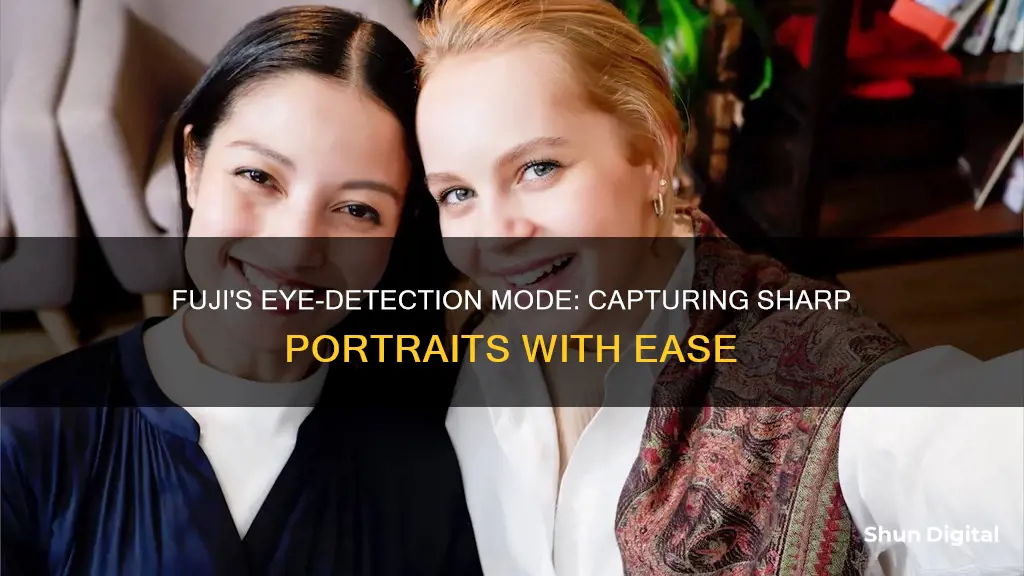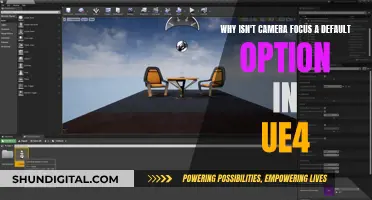
When it comes to portrait photography, focusing on the eyes is key. The Fujifilm X Series camera's Face/Eye Detection mode helps photographers ensure their subject's eyes are in focus, even when the subject is moving about. This feature can be switched on from the camera's main menu or its Q Menu, where it is included by default.
When Face/Eye Detection is on, the camera will automatically detect and highlight faces in the viewfinder, even before you've focused on them. A green box will highlight the face currently being tracked as a priority, with any other faces in the frame possibly highlighted with white boxes.
Photographers can also choose whether the camera detects and focuses on eyes when Intelligent Face Detection is on. There are four options to choose from: Intelligent Face Detection only; FACE ON/RIGHT EYE PRIORITY; FACE ON/LEFT EYE PRIORITY; and Intelligent Face Detection and eye priority off.
If the camera is unable to detect the subject's eyes because they are hidden by hair, glasses, or other objects, the camera will instead focus on faces.
| Characteristics | Values |
|---|---|
| Camera model | X-T10, X-T2, X-T3, X-Pro2, X Series |
| Face/Eye Detection setting | Intelligent Face Detection, Face On/Right Eye Priority, Face On/Left Eye Priority, Intelligent Face Detection and Eye Priority Off |
| Face Detection | Detects human faces anywhere in the frame, indicated by a green border |
| Multiple faces in frame | Camera selects face closest to centre, other faces indicated by white borders |
| Eye Detection | Camera automatically chooses which eye to focus on, or user can select right or left eye priority |
| Face/Eye Detection limitations | May not work if eyes are hidden by hair, glasses, or other objects; may not work in low light or if the subject is moving |
What You'll Learn

Intelligent Face Detection
The Intelligent Face Detection feature on a Fujifilm camera is a powerful tool for creating portraits. It allows the camera to set the focus and exposure for human faces anywhere in the frame, ensuring that the camera does not focus on the background in group portraits. This feature is especially useful when the subject is moving or the photographer is shifting positions, as it eliminates the need to constantly refocus to ensure the subject remains sharp.
To activate Intelligent Face Detection, press MENU/OK to display the shooting menu and select "ON" for FACE DETECTION. Faces can be detected with the camera in either vertical or horizontal orientation. If a face is detected, it will be indicated by a green border. If there is more than one face in the frame, the camera will select the face closest to the centre, with other faces indicated by white borders.
In addition to Intelligent Face Detection, you can also choose whether the camera detects and focuses on eyes. There are several options available:
- Intelligent Face Detection only: The camera automatically chooses which eye to focus on when a face is detected.
- FACE ON/RIGHT EYE PRIORITY: The camera focuses on the right eye of subjects detected using Intelligent Face Detection.
- FACE ON/LEFT EYE PRIORITY: The camera focuses on the left eye of subjects detected using Intelligent Face Detection.
- Intelligent Face Detection and eye priority off: If the camera is unable to detect the subject's eyes because they are hidden by hair, glasses, or other objects, it will instead focus on faces.
It is important to note that in some modes, the camera may set the exposure for the entire frame rather than just the portrait subject. Additionally, if the subject moves as the shutter button is pressed, their face may not be within the green border when the picture is taken.
Activating Macro Mode on Panasonic Cameras: A Step-by-Step Guide
You may want to see also

Focus mode C
When using Focus mode C on a Fuji camera, the camera will track the focus on the subject in the selected focus point while the shutter-release button is pressed halfway. This is in contrast to Focus mode S, where the camera automatically focuses on high-contrast subjects, and the areas in focus are shown in the display.
To use Focus mode C, you need to select the AF mode for focus modes S and C. This allows you to choose the focus point for autofocus. You can also choose the focus zone, which includes multiple focus points (5 x 3, 5 x 5, or 3 x 3), making it easier to track subjects that are moving.
In Focus mode C, the camera may struggle with focusing on small objects or subjects that are moving very fast. Additionally, focus zoom is not available in this mode.
It's important to note that Eye-detection AF is not available in Focus mode C. If you want to utilise Eye-detection AF, you should use Focus mode S, where the camera will automatically focus on high-contrast subjects, such as eyes.
Charging Drift HD Camera Batteries: A Step-by-Step Guide
You may want to see also

Focus mode S
The Focus mode S on a Fuji camera is one of the autofocus settings. It is used to automatically focus on high-contrast subjects, with the areas in focus shown on the display. The camera focuses on the subject in the selected focus point, which is useful for pin-point focus on a selected subject.
When using focus mode S, you can choose how the camera focuses in focus mode AF-S or AF-C. Shutter response is prioritized over focus in AF-S, meaning pictures can be taken when the camera is not in focus. In AF-C, focus is prioritized over shutter response, meaning pictures can only be taken when the camera is in focus.
In addition, when the AF-L button is pressed in manual focus mode, you can choose whether focus is adjusted at the time the button is pressed or continuously while the button is pressed.
Finding the Battery Switch on Your Kidizoom Camera
You may want to see also

Face on/right eye priority
The "Face-on/right eye priority" mode on a Fuji camera is a setting within the Intelligent Face Detection feature. This mode is designed to focus specifically on the right eye of the subject when their face is detected using Intelligent Face Detection.
Intelligent Face Detection is a powerful tool for creating portraits, as it allows the camera to focus on the subject's face and eyes, ensuring they are sharp and in focus. This is especially useful when working with a shallow depth of field, as it can make the difference between someone's eyes being in focus or their nose being the focal point.
To activate the "Face-on/right eye priority" mode, first enable Intelligent Face Detection. You can do this by accessing the shooting menu and selecting "ON" for Face Detection. Once Intelligent Face Detection is activated, you can choose to enable eye detection and select "RIGHT EYE PRIORITY." With this setting, the camera will focus on the right eye of the detected subject.
The "Face-on/right eye priority" mode is useful when you want to ensure that the right eye of your subject is in focus, especially in portrait photography. This mode can be easily accessed through the Q Menu on your Fuji camera, allowing you to quickly adjust your settings and capture the perfect shot.
It's important to note that the camera will automatically select the face closest to the center of the frame when using Intelligent Face Detection. If there are multiple faces in the frame, the other faces will be indicated by white borders. Additionally, if the camera is unable to detect the subject's eyes due to obstructions like hair or glasses, it will instead focus on the face as a whole.
Charging Your Fujifilm Camera: A Step-by-Step Guide
You may want to see also

Face on/left eye priority
The Fujifilm camera's Face/Eye Detection AF is a powerful tool for creating portraits. The eyes are an important aspect of portraiture, as they are often the window to the subject's soul, revealing subtleties of emotion and expression. The best way to place focus on someone's eyes is by being selective with what's in focus. This is where your X Series camera's Face/Eye Detection comes in.
Face/Eye Detection AF can be switched on from your camera's main menu or its Q Menu, where it's included by default. You can cycle through four modes: Intelligent Face Detection, Face On/Right Eye Priority, Face On/Left Eye Priority, and Intelligent Face Detection and Eye Priority Off.
In the Face On/Left Eye Priority mode, the camera focuses on the left eye of the subjects detected using Intelligent Face Detection. This mode ensures that the left eye of the subject, as seen from the photographer's perspective, is always in focus. This is especially useful when you want to create a compelling portrait with a shallow depth of field, ensuring that the subject's left eye is the focal point.
To use this mode effectively, you can adjust the autofocus settings. Choose the focus point for autofocus and utilise the Focus-area selection to select the focus point for manual focus and focus zoom. The camera will focus on the subject within the selected focus point, allowing for pinpoint focus. Additionally, you can choose the AF mode for focus modes S and C. In focus mode C, the camera will track the focus on the selected focus point while the shutter-release button is pressed halfway. On the other hand, in focus mode S, the camera will automatically focus on high-contrast subjects, and the areas in focus will be shown in the display.
The Face On/Left Eye Priority mode is an excellent choice for photographers who want to emphasise the left eye of their subjects, adding a unique perspective and creativity to their portraits.
Unlocking Macro Mode: How to Check Your Camera
You may want to see also
Frequently asked questions
Eye Detection can be turned on from your camera's main menu, but it is more easily accessed from its Q Menu, where it is included by default.
The best way of placing focus on someone's eyes is by being selective with what's in focus. Using a wide aperture to generate a shallow depth-of-field is a classic technique for photographing people.
You can cycle through four modes: Intelligent Face Detection only, FACE ON/RIGHT EYE PRIORITY, FACE ON/LEFT EYE PRIORITY, and Intelligent Face Detection and eye priority off.
This is likely because your focus mode is set to Manual Focus (MF). Face and Eye Detection only work in AF-S or AF-C modes.







